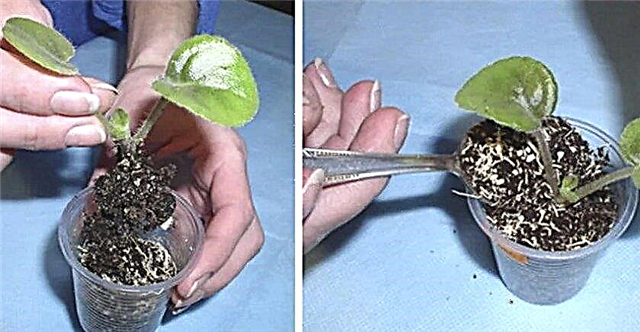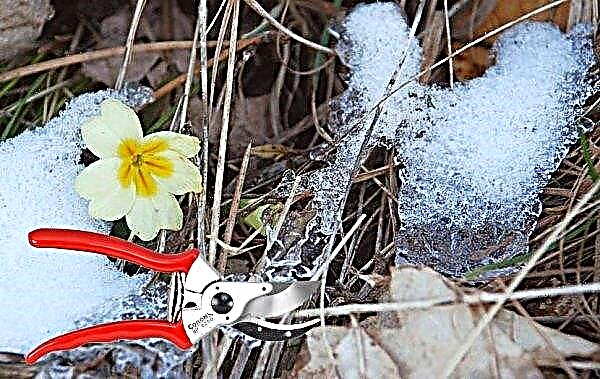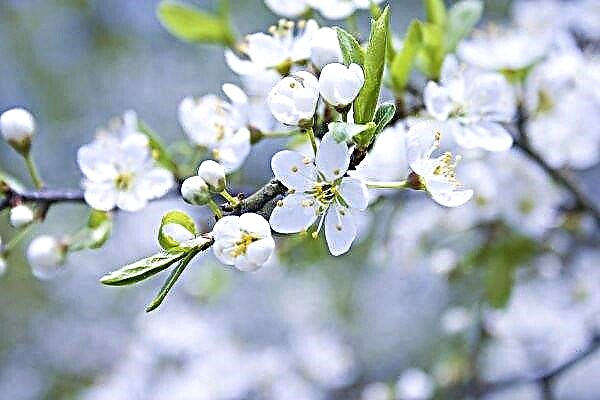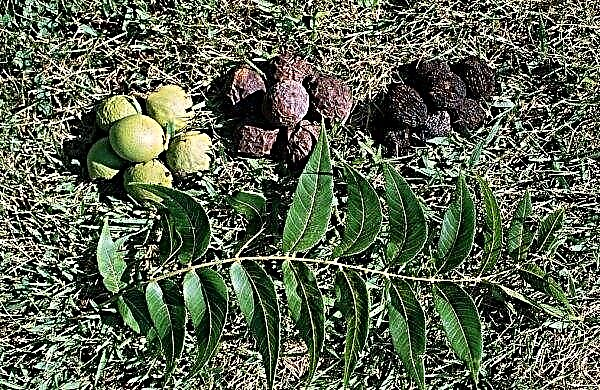Violet is an amazing and sophisticated flower, loved by every mistress. It seems that all the tenderness and awe of nature personified in this humble plant. In addition, violet (also known as senpolia) has botanical characteristics inherent only to it. There are many varieties of violets, among which a variety called Don Juan stands out especially. Consider its characteristics, conditions for growing and subtleties in care.
Botanical description of the plant
Violet is an annual or perennial plant of the family Violet (Violaceae) of the class Dicotyledonous. Senpolia is very popular for growing at home. In many countries, there are clubs and private collections with hundreds of varieties and sports. Violets are called sports, a plant that, by the time of the growing season, has found differences from the main characteristics of the variety. Sports can appear as a result of the slightest deviations in the process of care, as well as due to microclimatic differences.Ampelic, variegated, mini, semi-double and terry varieties are distinguished. Plants are also classified by color: white, pink, purple, blue, etc.
Photo gallery
RS – Don Juan is a variety, but it can also become the progenitor of hundreds of sports. It is classified as violet. This variety is relatively new, it was bred in a private collection in 2013 and got its name thanks to the special appeal that its historical character possessed.Violet Don Juan has a large outlet - up to 40 cm in diameter. The leaves are dark green, wide, with a pink outline, velvet, wavy. Terry or semi-double flowers are characterized by a rich dark violet or purple-black color with light green, less often - a yellow border. The velvet surface of the flowers has the shape of a star, which can reach up to 6 cm in diameter. The back of the petals is light.
Did you know? Now in the world more than 8500 species of varieties of indoor violet are registered. The official calculation is carried out by the American Society of Senpoly Fans - AVSA, which began its activities in 1946. It is engaged in the registration of new varieties and the publication of an annual catalog with their full description.
The wavy the leaf - the thicker the border of the flower will be. Violet blooms at home throughout the year. The standard period lasts from March to December (2-3 months in a year, the senpolia rests), however, it may vary depending on the conditions of care. Some varieties bloom throughout the year without rest. The survival rate of cuttings is good. As a rule, Don Juan sports are distinguished by the color of their flowers.
Basic conditions for growing violets at home
The complexity of caring for senpolia at home is indicated as average, but it has its own subtleties. Accidental carelessness in the care can lead to irretrievable wilting of the flower. Lack of flowering in violets is a very common occurrence, especially among inexperienced breeders.  This problem directly indicates a violation in the conditions of detention, which do not differ in different varieties. Factors of watering, lighting and temperature conditions play a key role in the formation of the plant, so we will get acquainted with them in more detail.
This problem directly indicates a violation in the conditions of detention, which do not differ in different varieties. Factors of watering, lighting and temperature conditions play a key role in the formation of the plant, so we will get acquainted with them in more detail.
Placement and lighting
Don Juan's flower is especially susceptible to light. On the one hand, he needs it, but excessive exposure to direct sunlight is no less harmful to him. The ideal arrangement of the pot will be the southern room with diffused light. If you decide to grow a flower on the windowsill of the southern room, then take care to set the dimming to the border of the flower's growth. This will help diffuse the light and make its effect softer.
Curtains, fabric, foil, blinds, etc. can serve as such a “dimming”. An arrangement of a pot with a violet in the kitchen will be no less successful. Like other indoor flowers, violet will like the warm kitchen air, its moderate humidity and soft light. In winter, the pot on the windowsill is placed so that the leaves of the plant do not touch the cold window glass.  Saintpaulia is a photophilous plant and needs to be exposed 12–13 hours a day, therefore, if after the dark stage of the day you have the opportunity to provide violet with continuous artificial light (moderate brightness), the plant will thank you with lush and colorful flowers.
Saintpaulia is a photophilous plant and needs to be exposed 12–13 hours a day, therefore, if after the dark stage of the day you have the opportunity to provide violet with continuous artificial light (moderate brightness), the plant will thank you with lush and colorful flowers.
Temperature and humidity
The optimal daily temperature for violets is considered to be +20 ... + 25 ° C throughout the year. Accordingly, in the hot summer months, it is recommended to move the flower to cooler rooms or to control the temperature regime with the help of fans and air conditioners. The roots of violets are very quivering and are afraid of a sharp temperature drop, so if you ventilate the room, then the pots with senpolia should be moved to a warm place. The night temperature should differ from the daytime temperature by 2-3 degrees. From the slightest draft or stream of cold air, the violet can wilt. An important factor is maintaining air humidity conditions. To do this, you can install containers with water next to the pot, move the pot to special trays with water (like orchid watering), or install special air humidifiers. Humidity should vary between 50–70%. If the indicator reaches more than 70%, rot may form.
An important factor is maintaining air humidity conditions. To do this, you can install containers with water next to the pot, move the pot to special trays with water (like orchid watering), or install special air humidifiers. Humidity should vary between 50–70%. If the indicator reaches more than 70%, rot may form.
Did you know? Since ancient times, touching and tender violets were worshiped by writers, poets and monarchs. Candied violet was the favorite delicacy of the Austrian Empress Sissy. To this day, this sophisticated dessert is made in old Viennese pastry shops and is considered a symbol of lovers.
How to care at home
Creating ideal conditions is not enough to guarantee the formation of a healthy plant. Violet care includes irrigation rules, adhering to the feeding regimen, the nuances of entering the necessary vitamins into the soil, as well as the rules for pruning and replanting.
Watering
Saintpaulia Don Juan is afraid of water falling on leaves and flowers, because this can lead to decay or hypothermia. Many housewives have adapted to irrigate directly into the pot, however, the ideal option for violets would be watering in pallets or immersion in a container of water (here, an example of orchid watering is also an example). For this, a pot with a plant is placed for 15–20 minutes in a larger pot or in a deep tray filled with water (must be left standing for at least 24 hours).  The water temperature should be slightly warmer than room temperature (+21 ... + 24 ° C). When calculating the irrigation regime, they are repelled from microclimatic conditions. Water the plant so that the topsoil is always slightly moist. Drying out of the crust may be detrimental to the flower.
The water temperature should be slightly warmer than room temperature (+21 ... + 24 ° C). When calculating the irrigation regime, they are repelled from microclimatic conditions. Water the plant so that the topsoil is always slightly moist. Drying out of the crust may be detrimental to the flower.
Important! During the heating period, it is advisable, in addition to watering, to perform the procedure of moistening the soil. To do this, put the pot with violet in a tray with warm water so that it does not touch it. Special moisturizing substrates, such as wet pebbles, can also be used.
Top dressing
Topping up is necessary for violets as well as other indoor plants. Of course, you can refrain from this procedure, but a couple of months after planting, the soil in the pot is depleted, and in order not to carry out the transplant procedure again, fertilizing is introduced. The main nutrients for the senpolia are nitrogen (it affects the formation of leaves, respectively, it is introduced to a young plant), phosphorus and calcium (these minerals affect flowering, therefore, are introduced during the growing season). It is very important to observe the proportions, so you need to carefully read the instructions on the package.
Video: Feeding violets
Fertilizers for violets are usually administered in the following ways:
- Through the soil. To do this, the preparations are diluted in warm, settled water, water the plant and make sure that the solution does not fall on the leaves.
- Through the root. A flower pot is placed in a tray with a solution for a certain time.
- Through the leaves. This method allows the plant to take nutrients faster, but it requires increased accuracy and is not recommended for inexperienced gardeners.
- liquid (“Mr. Color”, “Master Color”, “Agrecol-gel”, “Green Doctor”, “Growth”);
- crystalline (“Royal Mix”, “NPK +”, “Blank sheet”);
- organic ("Separated vermicompost", "Green Guy", "Osmokot", "Gumi-Omi", "Green Decor", "Master Agro").
Pruning
Senpolia of Don Juan variety does not belong to widely growing plants. As a rule, it forms a compact outlet and does not release leaves with a thick nozzle. However, the violet also sometimes needs pruning to help her form a neat and aesthetically beautiful bush. It is believed that three rows of leaves are sufficient for the senpolia, which are peduncles and the basis of the plant, therefore older leaves of the lower rows are removed. This procedure can be performed by plucking, and if this is not possible, then seek help from a tool that must be sharp and sanitized. Do not forget to trim dried and yellowed leaves and stepsons. You can trim the greenery of the lower rows, which is knocked out of the general harmony of the bush (grows to the side, has a different shape or stretches up). Slices of the plant are treated with activated carbon powder. This will help protect the "wound" from infections, moisture and pests. The procedure is usually carried out in March or April, after the plant leaves the sleep period.
This procedure can be performed by plucking, and if this is not possible, then seek help from a tool that must be sharp and sanitized. Do not forget to trim dried and yellowed leaves and stepsons. You can trim the greenery of the lower rows, which is knocked out of the general harmony of the bush (grows to the side, has a different shape or stretches up). Slices of the plant are treated with activated carbon powder. This will help protect the "wound" from infections, moisture and pests. The procedure is usually carried out in March or April, after the plant leaves the sleep period.
In addition to the aesthetic function, pruning will help to evenly distribute the absorption of nutrients and vitamins among young herbs. The plant will not spend energy on old and fading plates and, thus, will form a rejuvenated, healthy and lush rosette.
Transfer
Transplanting violets is a mandatory procedure that is performed at least once a year. The earth becomes denser over time, accumulates salts, increases acidity and loses useful trace elements that do not enter the plant and it ceases to bloom. This is one of the main problems faced by mistresses of violets.
For better adaptation of the flower, the transplant should be carried out in the spring, before the growing season. The step-by-step procedure is as follows:Important! The breathable soil structure is very important for the Senpoly, so changing the soil will help saturate the plant's roots with oxygen and nutrients.
- We prepare a pot for transplantation. It should only be a size larger than the previous one, since the violet better adapts to a cramped space. The pot must have openings for moisture condensation. It is better to choose plastic options, because clay and ceramic absorb moisture faster, which violets just do not need. We put drainage on the bottom (expanded clay, broken brick, moist soil with peat) and fill the soil to the middle of the pot. Soil choose moderate acidity.
- We take the plant out of the old pot, for this we turn it over and, slightly shaking, take out the violet. If the roots of the plant densely encircled the bottom of the pot - this is another signal to the fact that the transplant is carried out in a timely manner.
- Gently clean the roots of the old earth. We remove old leaves, side rosettes and wilted parts of greenery.
- We plant the plant in a new pot, add earth, ramming it tightly.
- Water the rejuvenated violet a day after the transplant, this will help her to take root better.
The old pot can be washed, treated with boiling water and used for other plants.
Video: How to transplant a violet
How to propagate at home
To propagate violets Don Giovanni use five methods. We consider in detail each of them:
- Cuttings. This is the most popular and easiest way to grow "kids." To do this, a leaf is plucked from the main bush (along with the cuttings) and planted in the soil to a depth of 0.5–1 cm (depending on the size of the cuttings). It is recommended to take the leaf of medium size from the second row of the outlet, since it is fruitful, and at the same time it will not damage the mother plant. After planting the cuttings, the soil is abundantly watered, but remember that the liquid should not fall onto the leaf itself. The pot is covered with a bag or can to create a greenhouse environment.
 For the survival of the sprout, the air temperature should be at least + 21 ° C, so it is better to cuttings in the spring-summer period. If everything was done correctly, then in a month you will receive an ingrained handle that will let the “children” in (over time, they will need to be removed from the mother's handle). Survival occurs in 90% of transplants. Sometimes the stem is first rooted in warm water and only then planted in the soil. So you will be able to observe the growth of the spine, which is very delicate and, when further planted in the ground, will require maximum caution.
For the survival of the sprout, the air temperature should be at least + 21 ° C, so it is better to cuttings in the spring-summer period. If everything was done correctly, then in a month you will receive an ingrained handle that will let the “children” in (over time, they will need to be removed from the mother's handle). Survival occurs in 90% of transplants. Sometimes the stem is first rooted in warm water and only then planted in the soil. So you will be able to observe the growth of the spine, which is very delicate and, when further planted in the ground, will require maximum caution. - The separation of the bush. This method can be used if the outlet with senpolia is abundantly overgrown with new bushes and it does not have enough space. To do this, carefully pull out the outlet from the pot and separate the newly formed lateral bushes, which are independent plants. They should be transplanted into smaller pots. Thus, several new violets are obtained and a place is freed up for the full development of the old flower. This method in most cases preserves the varietal qualities of violets.

- Getting a sprout from a peduncle. This method is less popular, since most housewives do not know how to separate the peduncle, are afraid to damage the violet, and are wary of this method. However, if you are ready for experiments and not afraid of difficulties, then be sure that after the cuttings of the peduncle, the violet will thank you with even more magnificent and bright flowering. The procedure begins with the separation of the most beautiful and strong peduncle. It is cut with a sharp tool at an angle so that the distance from the cut to the leaves is not less than 1 cm. Flowers and buds are plucked off, after which the peduncle is planted in a small pot in the soil or in another substrate and kept under the “greenhouse” as in the method with cuttings. After rooting and the formation of new leaves, the senpolia can be transplanted to a permanent habitat. Do not forget that the "greenhouse" needs to be ventilated every day for 30-40 minutes. It will take 1.5–2 months to get the sprout from the peduncle.
- Seed method. Is the most difficult. The survival rate of violets in inexperienced gardeners is 70%. When using this method, important factors are temperature and microclimate.
 At the slightest deviation from the conditions of care described above, you can not achieve seed growth. For the seed method, in any specialized store they purchase the favorite varieties of violets. Then they are planted in the ground according to the "seedling type": they arrange a greenhouse, provide warm and moist air, regularly feed them, after which the seedlings are transplanted into permanent pots.
At the slightest deviation from the conditions of care described above, you can not achieve seed growth. For the seed method, in any specialized store they purchase the favorite varieties of violets. Then they are planted in the ground according to the "seedling type": they arrange a greenhouse, provide warm and moist air, regularly feed them, after which the seedlings are transplanted into permanent pots. - Seed method with self-extraction of seeds. This method of reproduction for the most experienced and demanding breeders, in which pollen is transferred manually (using special tools) from the stamen to the pestle. The formation of seeds and their growth will take 11-12 months.
Growing difficulties
Violet Don Juan is susceptible to a lack of attention, so the lack of our care can lead to a lack of flowering or even death of the bush.Often flower growers are faced with problems caused by improper watering. In the senpolia, this is a thin line that runs between the lack and excess of water. After all, both of them are painful for her. If the violet leaves turn yellow - this indicates that the plant is contained in a room with dry air and it needs careful watering and moisturizing. Twisted leaves also indicate the need for watering. If the leaves and flower stalks began to fade, this is a signal that the plant had an excess of water and rot was formed in the roots. In this case, it needs to be transplanted into new soil and stop watering for the recovery time. Additionally, fungicides are treated. The appearance of dark brown spots on the leaves indicates the watering of the flower with cold, unstable water. Dimming also leads to a number of problems. With a sunburn and too bright lighting, light yellow spots appear on the violet leaves or they begin to fade. In this case, the flower pot is moved to another place, and the damaged greens are cut off over time.
Dimming also leads to a number of problems. With a sunburn and too bright lighting, light yellow spots appear on the violet leaves or they begin to fade. In this case, the flower pot is moved to another place, and the damaged greens are cut off over time.
In addition to biological disorders, there are infectious ones that are transmitted through insects (whiteflies, mealybugs, aphids, spider mites). If a pest is found (for example, a spider mite weaves sticky small cobwebs under the leaves and peduncles), you should immediately seek help from special medications. It can be insecticides “Fitoverm”, “Actofit”, “Anti-mite”, “Fitocide-R” and others. All damaged parts of greenery are removed from the plant, after which it must be abundantly sprayed with the preparation solution and covered with a bag or oilcloth for 2-3 days. This procedure is repeated 3 times every 5 days. Healthy indoor plants that delight the eye with bright colors are the result of our care and love. Violets are no exception. These delicate and modest flowers have been compelling people from different countries to bow to them for thousands of years, despite the demanding care. And even if you did not like violets earlier, then after they give you the appearance of new colors and subtle notes of aromas, you will undoubtedly become their fan.
Healthy indoor plants that delight the eye with bright colors are the result of our care and love. Violets are no exception. These delicate and modest flowers have been compelling people from different countries to bow to them for thousands of years, despite the demanding care. And even if you did not like violets earlier, then after they give you the appearance of new colors and subtle notes of aromas, you will undoubtedly become their fan.

 For the survival of the sprout, the air temperature should be at least + 21 ° C, so it is better to cuttings in the spring-summer period. If everything was done correctly, then in a month you will receive an ingrained handle that will let the “children” in (over time, they will need to be removed from the mother's handle). Survival occurs in 90% of transplants. Sometimes the stem is first rooted in warm water and only then planted in the soil. So you will be able to observe the growth of the spine, which is very delicate and, when further planted in the ground, will require maximum caution.
For the survival of the sprout, the air temperature should be at least + 21 ° C, so it is better to cuttings in the spring-summer period. If everything was done correctly, then in a month you will receive an ingrained handle that will let the “children” in (over time, they will need to be removed from the mother's handle). Survival occurs in 90% of transplants. Sometimes the stem is first rooted in warm water and only then planted in the soil. So you will be able to observe the growth of the spine, which is very delicate and, when further planted in the ground, will require maximum caution.
 At the slightest deviation from the conditions of care described above, you can not achieve seed growth. For the seed method, in any specialized store they purchase the favorite varieties of violets. Then they are planted in the ground according to the "seedling type": they arrange a greenhouse, provide warm and moist air, regularly feed them, after which the seedlings are transplanted into permanent pots.
At the slightest deviation from the conditions of care described above, you can not achieve seed growth. For the seed method, in any specialized store they purchase the favorite varieties of violets. Then they are planted in the ground according to the "seedling type": they arrange a greenhouse, provide warm and moist air, regularly feed them, after which the seedlings are transplanted into permanent pots.










